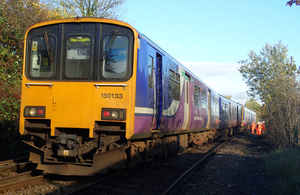Derailment near Knaresborough
Investigation into a passenger train derailment near Knaresborough, 7 November 2015.

Image of incident train near Knaresborough
At 07:22 hrs on 7 November 2015, the 06:52 hrs Northern Rail passenger service from York to Harrogate derailed on points 3A between Cattal and Knaresborough stations. The train (reporting number 2C07) consisted of two Class 150, 2-car multiple units.
At this location the single line section of track changes to double track (a crossover). The intention was for the train to remain on the down main line and not to use the crossover.

Simplified diagram showing track and signal arrangement near Knaresborough station
Train movements at this location are controlled from Knaresborough signal box, using a lever frame and relying on a mix of mechanical and electrical interlocking. The line speed in this area is 65 mph (104 km/h) but the train was travelling at 19 mph (30 km/h) at the time of the derailment, having been authorised to pass signal K10 at danger (red). Signal K10 protects the crossover.
The leading 5 bogies derailed and damage was sustained by both the train and track. None of the train crew or five passengers on board were injured. The line was re-opened at 12:58 hrs on 8 November 2015.
Train 2C07 was authorised past signal K10 at danger by the signaller in Knaresborough signal box after the signaller experienced difficulties clearing the signal. These difficulties were almost certainly associated with the points 3A not being in a safe condition for the train to pass.
The signaller was appointed to work Knaresborough signal box the afternoon before the derailment as the resident signaller was sick. He had not operated the signal box for a number of months.
Our investigation will include examination of:
- the sequence of events, including the actions of the signaller and train driver
- the design of the signal box
- the processes in place for appointing relief signallers
- any relevant underlying management issues.
Our investigation is independent of any investigation by the railway industry or by the industry’s regulator, the Office of Rail and Road.
We will publish our findings, including any recommendations to improve safety, at the conclusion of our investigation. This report will be available on our website.
You can subscribe to automated emails notifying you when we publish our reports.